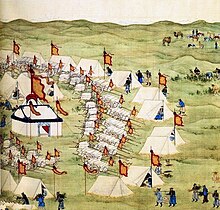Khungtaiji Galdan
Khungtaidschi Galdan ( Mongolian ᠺᠠᠯᠳᠠ ᠪᠥᠱᠦᠭᠲᠦ ᠬᠠᠭᠠᠨ Galdan Boshigt Khan / Галдан бошигт хаан , * 1632 or 1644; † April 4 (?) 1697 ) was from 1676 Khan of the Djungarian Khanate and ruler of the Djungars . Under him the Djungarian Empire expanded and was not stopped until 1690 and 1696 by the Qing dynasty under Emperor Kangxi .
The son of Khungtaidschi Batur was originally supposed to be trained as a monk in Tibet . After the murder of his older brother Khungtaidschi Sengge by his half-brothers in 1671, however, he returned, avenged the murder and took over the rule. He received the title of Khan from the Dalai Lama .
In the political tradition of his father, he endeavored to reunite the Oirat tribal groups and to join the neighbors. His campaigns were directed on the one hand against the Oriental, i.e. West Mongolian Choschuten and the East Mongolian Khalka, as well as against the Kazakhs .
Against the Choschuten and Khalka
In 1677, he attacked the Choschuten -Khan Uchirtu Secen , a potential rival, and killed him, whereby all non-migrated tribes were united under his rule. Uchirtu Secen was not only related by marriage to Galdan, but also to Tüsiyetü Khan Caqundorji of the Khalka , and so this led to the conflict with Caqundorji, which intensified in 1686/87 when the Jasaktu Khan Sar defected to Galdan. Caqundorji saw his territory threatened by enemy attacks, ambushed the allies and killed the Jasaktu-Khan Sar and Galdan's younger brother Dorjijab .
Galdan moved in with the Khalka with 30,000 men and completely defeated Caqundorji with his son Galdandorji in two battles near Tömör and on Lake Olgoj. Then Caqundorji fled with the spiritual head of the Khalka, Jebtsundamba Khutukhtu Dsanabadsar to the Manchu Emperor Kangxi and in 1691 sealed the connection of the Khalka to the Manchu Empire in a ceremony in Dolon Nor .
Against the Kazakhs
Between 1681 and 1695 Galdan repeatedly waged war against the Kazakhs in the Syr Darya area, taking one of the son Tauke Khan prisoner. During his reign, the remaining Chagatai Khanate in Kashgaria was liquidated in favor of a family of Hodjas . In 1678, at the request of the Dalai Lama, Galdan deposed Isma'il , a descendant of this sex. Instead, he put the Hodscha Hazrat Apak (also: Abakh Khoja or Hidayatullah, † 1693/4) as his vassal. The Hodscha rule proved to be tough, it dominated local politics from the 16th to the 19th century, partly at the expense of the Djungars.
Attacks by the Chinese
The Manchu Emperor Kangxi advanced personally against Galdan in 1690 with the support of the Khalka and with the use of muskets and modern artillery and triumphed at Ulan Budung under Prince Fu-ch'üan.
After extensive logistical preparations, three Chinese armies marched through the Gobi desert . They succeeded in forming the Djungarian units; on June 13, 1696, the Chinese under General Fiyanggü won at Juun modun . Here came u. a. Galdan's wife Ana Dara perished. Shortly thereafter, Galdan committed suicide or died of complications from a brain hemorrhage. Galdan's nephew Tsewangrabtan took the opportunity to become Khan of the Djungars himself and handed over some family members and the ashes of Galdan to Kangxi.
literature
- Udo B. Barkmann: History of Mongolia or the "Mongolian Question". The Mongols on their way to their own nation-state . Bouvier, Bonn 1999, ISBN 3-416-02853-8 .
- Michael Weiers (Ed.): The Mongols. Contributions to their history and culture . Scientific Book Society, Darmstadt 1986, ISBN 3-534-03579-8 .
| personal data | |
|---|---|
| SURNAME | Khungtaiji Galdan |
| ALTERNATIVE NAMES | Galdan Boshigt Khan |
| BRIEF DESCRIPTION | Ruler of the Djungars |
| DATE OF BIRTH | 1632 or 1644 |
| DATE OF DEATH | around April 4, 1697 |

